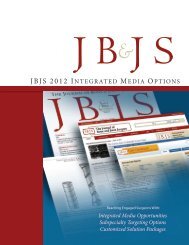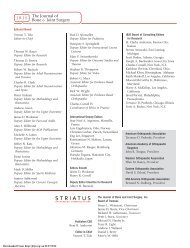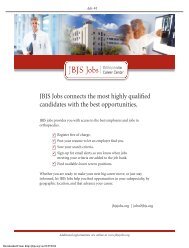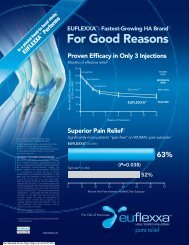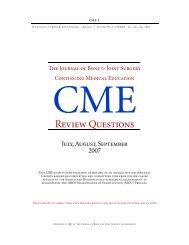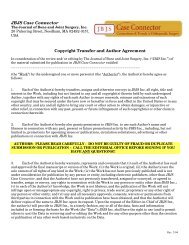Lower-Extremity Rotational Problems in Children - The Journal of ...
Lower-Extremity Rotational Problems in Children - The Journal of ...
Lower-Extremity Rotational Problems in Children - The Journal of ...
Create successful ePaper yourself
Turn your PDF publications into a flip-book with our unique Google optimized e-Paper software.
46 L. T. STAHELI, MARILYN CORBETT, CRAIG WYSS, AND HOWARD KING<br />
the normal range is from about zero to 45 degrees <strong>of</strong> lateral<br />
rotation, with a mean <strong>of</strong> 25 degrees.<br />
<strong>The</strong> thigh-foot angle is a composite measurement that<br />
reflects rotation <strong>of</strong> both the tibia and the h<strong>in</strong>d part <strong>of</strong> the<br />
foot3 . This angle roughly parallels the angle <strong>of</strong> the trans<br />
malleolar axis, but its mean value is lower (Fig. 3).<br />
<strong>The</strong> thigh-foot angle is easier to measure than the angle<br />
<strong>of</strong> the transmalleolar axis and is the most practical mea<br />
surement <strong>of</strong> the usual torsional deformity. However, for<br />
more complex torsional deformities, such as the torsion<br />
associated with a club foot, measurements <strong>of</strong> both the trans<br />
malleolar axis and the thigh-foot angle are useful. <strong>The</strong>se<br />
measurements clarify the anatomical location <strong>of</strong> the de<br />
formity. Thus, torsional deformity <strong>of</strong> the tibia is assessed<br />
by the angle <strong>of</strong> the transmalleolar axis; deformity <strong>of</strong> the<br />
h<strong>in</strong>d part <strong>of</strong> the foot is assessed by the difference between<br />
the angle <strong>of</strong> the transmalleolar axis and the thigh-foot angle;<br />
a comb<strong>in</strong>ed deformity <strong>of</strong> both the tibia and the h<strong>in</strong>d part <strong>of</strong><br />
the foot, by the thigh-foot angle; and f<strong>in</strong>ally, deformity <strong>of</strong><br />
the middle and distal portions <strong>of</strong> the foot, by the difference<br />
between the cl<strong>in</strong>ical measurements <strong>of</strong>the h<strong>in</strong>d and fore parts<br />
<strong>of</strong> the foot.<br />
Foot<br />
Deformities <strong>of</strong> the foot were not assessed <strong>in</strong> this study.<br />
<strong>The</strong> most common foot deformities affect<strong>in</strong>g the rotational<br />
pr<strong>of</strong>ile are metatarsus adductus produc<strong>in</strong>g <strong>in</strong>-toe<strong>in</strong>g and the<br />
hypermobile flat foot produc<strong>in</strong>g out-toe<strong>in</strong>g.<br />
Lateral rotation caused by eversion <strong>of</strong> the foot is see<br />
ondary to jo<strong>in</strong>t laxity or muscle imbalance. Such foot de<br />
formities are detectable dur<strong>in</strong>g the physical exam<strong>in</strong>ation and<br />
should be the last entries <strong>in</strong> the rotational pr<strong>of</strong>ile.<br />
Conclusions<br />
Dur<strong>in</strong>g <strong>in</strong>fancy. the rotational pr<strong>of</strong>ile appears to be<br />
References<br />
<strong>in</strong>fluenced by the effects <strong>of</strong> <strong>in</strong>trauter<strong>in</strong>e mold<strong>in</strong>g. <strong>The</strong> hips<br />
are flexed and laterally rotated <strong>in</strong> utero, result<strong>in</strong>g <strong>in</strong> greater<br />
lateral than medial rotation <strong>of</strong> the hips and femora. <strong>The</strong> feet<br />
are medially rotated, produc<strong>in</strong>g medial rotation <strong>of</strong> the tibia<br />
and sometimes metatarsus adductus. <strong>The</strong> spontaneous res<br />
olution <strong>of</strong> mold<strong>in</strong>g results <strong>in</strong> equalization <strong>of</strong> medial and<br />
lateral rotation <strong>of</strong> the hip, lateral rotation <strong>of</strong> the tibia, and<br />
decreas<strong>in</strong>g variability <strong>in</strong> the foot-progression angle dur<strong>in</strong>g<br />
the second year <strong>of</strong> life.<br />
Genetic factors effect the rotational pr<strong>of</strong>ile dur<strong>in</strong>g early<br />
childhood. Medial femoral torsion becomes evident at the<br />
age when medial rotation is greatest. Cont<strong>in</strong>ued lateral ro<br />
tation <strong>of</strong> the tibia corrects residual medial tibial-torsion an<br />
gulation.<br />
Dur<strong>in</strong>g late childhood, medial rotation <strong>of</strong> the hip di<br />
m<strong>in</strong>ishes, correct<strong>in</strong>g <strong>in</strong>-toe<strong>in</strong>g due to femoral torsion. Con<br />
t<strong>in</strong>ued lateral rotation <strong>of</strong> the tibia, however, may aggravate<br />
a lateral tibial-torsion deformity. Dur<strong>in</strong>g adult years. the<br />
rotational pr<strong>of</strong>ile is relatively constant except for medial<br />
rotation <strong>of</strong> the hip, which decreases, presumably due to a<br />
generalized loss <strong>of</strong> jo<strong>in</strong>t mobility with age.<br />
<strong>The</strong> graphs show<strong>in</strong>g normal values for the rotational<br />
pr<strong>of</strong>ile <strong>of</strong> the lower limbs will allow the cl<strong>in</strong>ician to deter<br />
m<strong>in</strong>e the location and severity <strong>of</strong> torsional problems. In the<br />
past, many <strong>in</strong>fants and children with normal rotational val<br />
ues were treated with spl<strong>in</strong>ts. braces, exercises, or even<br />
surgery.<br />
Such treatment is both harmful to the child and ex<br />
pensive for the parents.<br />
In evaluat<strong>in</strong>g children with torsional deformity. the<br />
potential for long-term disability <strong>in</strong> the absence <strong>of</strong> treatment<br />
and the risks <strong>of</strong> treatment should be weighed. Non-operative<br />
treatments are usually <strong>in</strong>effective. <strong>Rotational</strong> osteotomies<br />
<strong>of</strong> the femur or tibia are effective but are associated with<br />
significant complication rates.<br />
I. ASHTON.B. B.: PICKLES.BARRIE;and RoLl.. J. W.: Reliability <strong>of</strong> Gonionietric Measurements <strong>of</strong> Hip Motion <strong>in</strong> Spastic Cerebral Palsy. Devel.<br />
Med. and Child Neurol. . 20: 87-94. 1978.<br />
2. BOONE. D. C. . and AZEN. S. P.: Normal Range <strong>of</strong> Motion <strong>of</strong> Jo<strong>in</strong>ts <strong>in</strong> Male Subjects. J. Bone and Jo<strong>in</strong>t Surg. , 61-A: 756-759, July 1979.<br />
3. BooNE, D. C.: AZEN, S. P.:<br />
<strong>The</strong>r.. 58: 1355-1360. 1978.<br />
LIN, C.-M.; SPENCE. CAROl.: BARON. CAROl.: and LEE. LYNN: Reliability <strong>of</strong> Goniometric Measurements. Phys.<br />
4. Coos, VAt.ERIE:DONATO.GERALDINE:HOUSER.CAROlYN:and BLECK.E. E.: Normal Ranges<strong>of</strong> Hip Motion <strong>in</strong> Infants Six Weeks, Three Months<br />
and Six Months <strong>of</strong> Age. Cl<strong>in</strong>. Orthop.. 110: 256-260, 1975.<br />
5. EKSTRAND.JAN: WIKTORSSON.MARGARETA:OBERG. BIRGITTA:and GIL[.QUIST.JAN: <strong>Lower</strong> <strong>Extremity</strong> Goniometric Measurements: A Study to<br />
Determ<strong>in</strong>e <strong>The</strong>ir Reliability. Arch. Phys. Med. and Rehab.. 63: 171-175. 1982.<br />
6. ENGEI..G. M.. and STAHELI.L. 1.: <strong>The</strong> Natural History <strong>of</strong> Torsion and Other Factors Influenc<strong>in</strong>g Gait <strong>in</strong> Childhood. A Study <strong>of</strong> the Angle <strong>of</strong><br />
Gait, Tibial Torsion, Knee Angle. Hip Rotation. and Development <strong>of</strong> the Arch <strong>in</strong> Normal <strong>Children</strong>. Cl<strong>in</strong>. Orthop.. 99: 12-17. 1974.<br />
7. FABRY, G.: Torsion <strong>of</strong> the Femur. Acta Orthop. Belgica. 43: 454-459. 1977.<br />
8. FABRY. GUY: MACEWEN. G. D.: and SHANDS. A. R. . JR.: Torsion <strong>of</strong> the Femur. A Follow-up Study <strong>in</strong> Normal and Abnormal Conditions.<br />
Bone and Jo<strong>in</strong>t Surg.. 55-A: 1726-1738. Dec. 1973.<br />
9. HAAS,S. S. Epps. C. H., JR.; and ADAMS.J. P.: Normal Ranges <strong>of</strong> Hip Motion <strong>in</strong> the Newborn. Cl<strong>in</strong>. Orthop.. 91: 114-I 18. 1973.<br />
J.<br />
10. HALPERN. A. A.: TANNER. JOSEPH:and RINSKY,LAWRENCE.:Does Persistent Fetal Femoral Anteversion Contribute to Osteoarthritis? A Prelim<strong>in</strong>ary<br />
Report.Cl<strong>in</strong>.Orthop..145:213-216.1979.<br />
II. HUTTER.C. G.. JR.. and SCOTT.WALTER:Tibial Torsion. J. Bone and Jo<strong>in</strong>t Surg.. 31-A: 511-518, July 1949.<br />
12. INSAI.L. JOHN: FALVO, K. A.: and WISE, D. W.: Chondromalacia Patellae. A Prospective Study. J. Bone and Jo<strong>in</strong>t Surg.. 58-A: 1-8, Jan. 1976.<br />
13. KATE. B. R.. and ROBERT. S. L.: <strong>The</strong> Angle <strong>of</strong> Femoral Torsion. J. Anat. Soc. India. 12: 8-lI. 1963.<br />
14. KUERMOSH.O. LLOR,G.: and WEISSMAN,S. L.: Tibial Torsion <strong>in</strong> <strong>Children</strong>. Cl<strong>in</strong>. Orthop.. 79: 25-31. 1971.<br />
15. KINGSLEY, P. C. , and OLMSTED. K. L.: A Study to Determ<strong>in</strong>e the Angle <strong>of</strong> Anteversion <strong>of</strong> the Neck <strong>of</strong> the Femur. J. Bone and Jo<strong>in</strong>t Surg..<br />
30-A:745-751.July1948.<br />
16. KNITTEL.GUNTER,and STAHELI.L. T.: <strong>The</strong> Effectiveness <strong>of</strong>Shoe Modificationsfor lntoe<strong>in</strong>g. Orthop. Cl<strong>in</strong>. North America. 7: 1019-1025. 1976.<br />
17. KOBYLIANSKY.E.: WEISSMAN. S. L.: and NATHAN. H.: Femoral and Tihial Torsion. A Correlation Study <strong>in</strong> Dry Bones. InternaL. Orthop.. 3:<br />
145-147, 1979.<br />
18. LANIER. J. C.: <strong>The</strong> lntoe<strong>in</strong>g Child. Treatment with a Simple Orthopedic Appliance. J. Florida Med. Assn.. 58: 19-23. Dec.<br />
19. LEDAMANY.P.: La torsion du tibia. Normale. pathologique. expérimentale. J. anal. physiol.. 45: 598-615. 1909.<br />
1971.<br />
20. Low. J. L.: <strong>The</strong> Reliability <strong>of</strong> Jo<strong>in</strong>t Measurement. Physiotherapy. 62: 227-229. 1976.<br />
THE JOURNAL OF BONE AND JOINT SURGERY



